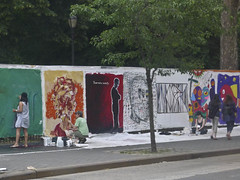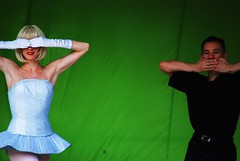 Tim Schreier A scene from this weekend’s Howl! Festival. Below: The cover of “Jack Kerouac and Allen Ginsberg: The Letters.”
Tim Schreier A scene from this weekend’s Howl! Festival. Below: The cover of “Jack Kerouac and Allen Ginsberg: The Letters.”Paul Rosenfeld, the critic, once wrote that, “Complex works of art speak not through individuals but ensembles.” In the early 1940s, on the steps of Columbia University, the original members of what became known as the “Beat Generation” — Jack Kerouac, Allen Ginsberg, Lucien Carr, William Burroughs — would form such a group.
The early Beats would strike off in several directions, on paths that would volley between the coasts and across the world, but they often returned to the Lower East Side where they got their start, and where their contribution to modern culture is celebrated in events like the Howl! Festival, named for Ginsberg’s game-changing 1955 poem. Ginsberg would have turned 85 years old last week — sufficient reason to look again at the passage of the Beats through our neighborhood and the influence they left.
The cheap apartments in the East Village in the 1940’s and 1950’s and the bohemian coffee houses and bars of downtown were a fecund soil for creative energy and experimental art. Ginsberg had the deepest connections among the group: his mother Naomi had been raised on the Lower East Side.
“Although I’m sure they were drawn to downtown New York by the existing art scene, we also have to bear in mind they were drawn to that sector for the rent. Which is why the art scene existed down there already,” said Kim Davis, associate editor of The Local and avid collector of bohemian literature. “The two things go together, artists and cheap rent, they converge.”
Ginsberg hopped around until finally settling in an apartment on East 12th Street, where he lived most of his life. Over the years he became a vital member of the community and a recognizable activist. Ginsberg was once mugged on East 10th Street, and responded, not by moving out, but by writing a poem about it.
“He was omnipresent in that whole Lower East Side scene,” said Cary Abrams, a friend of Ginsberg. “Back in the 60’s we didn’t have much celebrity culture. To the neighborhood, he was a writer, but he was also a personage and a fiber of the neighborhood, who chose to live here. He could have lived anywhere, but he lived here for 45 years until the time of his death.”
Novelist Jack Kerouac also frequented the East Village. It has been said he laid down a sizable chunk of his publisher’s advance for “The Town and the City,” buying books on Fourth Avenue’s “Book Row,” a four-block drag consisting of 22 used bookstores. According to Bill Morgan’s, “The Beat Generation in New York,” he often would eat at the Sagamore, on Third Avenue, a place he described as “the respectable bums’ cafeteria.” Afterward, he would fly across “dirty piss splashed sidewalks” to one of the Avenue’s many bars and insinuate himself among the dank, sooty atmosphere and working-class camaraderie; a lot more of his book advance must have been spent on beers and bottles of cheap wine. Some of those buildings are now gone; the piss-splashed sidewalks remain.
In those early days, most of the gravity for the downtown arts scene lay in Greenwich Village. Before the Beats’ arrival on the scene, the San Remo bar had long been home to a bohemian culture that had been imported, for the most part, from the shores of western Europe but was Americanizing quickly under the influence of the post-war generation of artists and poets. There were abstract painters, French surrealists-in-exile (surrealism’s ‘automatic writing’ practice foreshadowed the Beats’ “spontaneous prose”), socialists and anarchists, radical comedians and experimental writers, performance artists, and poets of all stripes.
“Although you’ve got this vibrant art scene happening in the village in the 1950’s there were all kinds of divisions in it as well. It was full of feuds and disagreements and territory disputes,” said Dr. Davis. “And these people would be criticizing each other, and telling each other they had no idea what they were doing.” Dan Wakefield, who described that scene in his book “New York in the Fifties,” recalls that many downtown writers initially regarded Jack Kerouac and his success as “a joke.”
The Beats took lessons not only from Greenwich Village’s bohemians, but from New York’s thriving junk scene, coming under the influence of streetwise users like the sometime writer, Herbert Huncke. Other role models, like the insatiably energetic Neal Cassady, always hunting for “kicks,” emerged from their trips cross country — “Whither goest thou, America, in thy shiny car in the night?” — and through the forgotten, down-and-out places of the world. In “On the Road,” Kerouac valorizes hobos and immigrant workers as sages of a new age, and romanticizes the African-American experience, filtering it through the wisdom and creativity of the jazz artists at the forefront of bop.
“To a great extent, I think they were trying to make sense of a racial world that seemed wrong to them, and to do this they were trying to figure out what the world was through the eyes of their African American contemporaries,” said John Leland, author of “Why Kerouac Matters.”
The Beats would later be criticized for a glamorous portrayal of that world, which ignored the social reality of the civil rights struggle. “You can criticize them for that but I’d say you have to bear in mind what they were doing was not presenting a political platform, but trying to present a poetic vision,” said Dr. Davis. “They were white middle-class guys from college who were actually saying there is a whole other part of America here that we want to embrace, as opposed to the America that’s being sold to us as art of the bourgeois dream.”
The message of Kerouac’s novels and Ginberg’s poems resonated with members of the budding boomer generation, who, fresh from the postwar economic boom, were trying to figure out how they wanted to spend their lives.
“The Beats had this idea that you didn’t have to live your life the way people told you you should. That you could orient yourself around experience rather than goals or accomplishments. That you could lead a spiritual life,” said Mr. Leland.
Bob Dylan was one of the early travelers who came to New York in search of the kicks that Sal and Dean (Kerouac and Cassady in thin disguise) had enjoyed in “On the Road.” He admits showing up in the Village with a battered copy of the book clutched in his hands. Even when the counterculture of the 1960’s eclipsed the Beat movement, and members of the circle began to go their separate ways, Ginsberg remained at the cultural center, continuing to embrace creative new acts of writing, music and experimental poetry.
“One important thing the Beats brought was a sense of the poetry to be found in beaten-up downtown neighborhoods,” said Dr. Davis. “By the mid-20th century people had gotten used to the idea that artistic subjects could be found in skyscrapers, airplanes, and industry and trains and all that kind of thing. The Beats managed to find great poetic and artistic beauty in the broken down parts of modern, industrial society. In the poem “Sunflower Sutra,” Ginsberg takes an image from William Blake, the sunflower, but he writes about a dead decaying sunflower in an urban landscape. And if you look around at what artists in the East Village are doing today, they’re still finding new ways of celebrating a damaged urban environment.”







